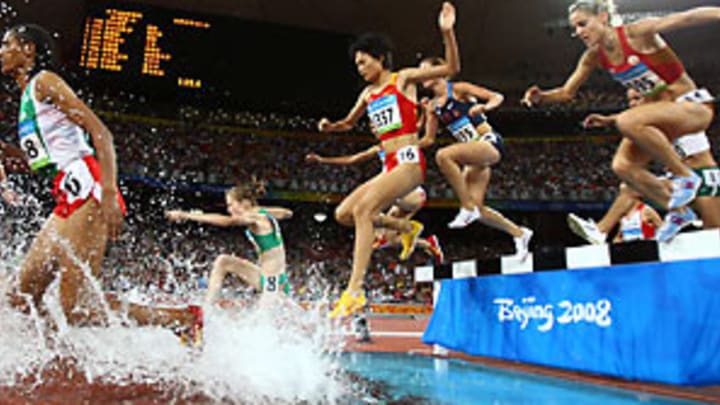The (steeple)chase is on


BEIJING -- On Friday night, at around 8:30 in the Bird's Nest, women's running completed a protracted journey. That's when the first of three heats in the first women's Olympic 3,000-meter steeplechase began. When the gun went off, it meant that, with the exception of the 50k racewalk, every track and field event that is contested at the Olympics for men, is also contested for women.
Current athletes might take it for granted, but it wasn't so long ago that such a feat hardly seemed possible. In 1928, the sight of several young women in the Olympic 800-meters crashing to the ground at the finish was so disturbing to some spectators that women's events over 200 meters were banned from the Olympics for the next 32 years. Even once they returned, the 1960s and '70s weren't exactly banner years for women's equality on the track and the roads.
Kathrine Switzer, the first woman to officially complete the Boston Marathon (but not before a race official jumped onto the course and tried to body-slam her out of the race) still refers to that time as "the Dark Ages."
That's when doctors would cook up whoppers to get her to stop running, from telling her that her uterus would collapse to suggesting her stomach muscles would be too taut to grant passage to a baby. Other women, she recalls, whispered that she would become manly, "like you'd get big legs and grow hair on your chest," Switzer says.
In 1984, the women's marathon was added, and the stars of that event -- JoanBenoit won the first -- became some of the most recognizable women in sports. In 2000, the women's pole vault was added to the Olympics, and the colorful stars of that event -- like the U.S.' Stacy Dragila, and Russia's Yelena Isinbayeva, the '08 favorite -- quickly became some of the most popular athletes in all of track and field, male or female.
For American track fans, who have suffered from a dearth of memorable distance performances at recent Olympics, the prelims of the inaugural women's steeple suggested there could be some new names worth remembering.
Two of the three Americans who ran last night qualified for the finals. (The last time a U.S. man made the steeple finals was in '96). One of those qualifiers, Jenny Barringer, was in high school when the Athens Games were taking place, and the other, Anna Willard, was waitressing. All three were proud to sport the red, white and navy blue in the first women's steeple.
Lindsey Anderson, 23, who graduated from Weber State last year, got to answer the call of the first Olympic women's steeple gun in the first heat of prelims. Anderson finished eighth in her heat, and didn't advance, but after the race had a smile when she mentioned that she was "part of the lucky 17 that got to share in that first race on an Olympic track."
In the second heat, Barringer, 21, who set the American record last month with a 9:22.73 in Germany, took third to move to Sunday's final. "It's phenomenal out there," Barringer said. "The [Olympic torch] flame, it sets you on fire. And with me and Anna making the final, we're setting the bar high [for U.S. women's steeple]."
Willard, with purple streaks in her bleach-blonde hair (they were supposed to come out blue, she says), said that she was simply overwhelmed by the chance to take part in history. (She finished sixth in the third heat and qualified on time.)
In the majestic Bird's Nest, with the towering flame flowing out of the oval opening in into the ink-black sky, and with the first women's steeplers hopping barriers far below, it was easy to be a bit overwhelmed.
